Launch and final orbit
acquisition,
Final orbit acquisition: basic principle,
Final orbit acquisition strategies,
Station keeping.
SPOT satellites are designed to acquire images of Earth in such a way that images taken
at different times can be compared with each other. This can only be achieved if each SPOT
satellite is in precisely the same orbit:
- The orbit is phased, which means that the satellite passes
repeatedly over a ground point after a whole number of days. The SPOT satellite cycle
takes 26 days to complete 369 orbital revolutions. The orbital period is
101.5 minutes. The ground track is accurately repeated every 26 days (cycle) and
the satellite follows adjacent ground tracks every five-day sub-cycle.
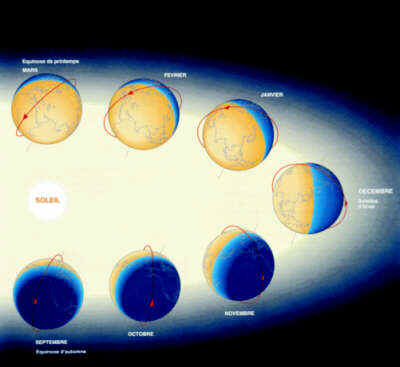
The angle between the orbital plane and the
Sun - Earth direction remains constant : this is why the orbit is known as
sun-synchronous.
|
The orbital plane intersects the equatorial
plane at two points along a straight line known as the line of nodes.
A node is the point at which the satellite crosses the equatorial plane:
- on its journey from north to south it is the descending node; for
SPOT's orbit, the descending node takes place during the "day" (in the sunlit
part of the orbit)
- on its journey from south to north it is the ascending node; for SPOT's
orbit, the ascending node takes place during the "night".
|
|
- The orbit is sun-synchronous, i.e. the angle between the orbital
plane and the Earth-Sun direction is almost constant. For SPOT satellites, this is a
22.5° angle, which means that the local time of the descending node is 10:30. This
means that imagery is acquired at a given latitude with constant illumination.
- The orbit is near-polar. This characteristic is a consequence of the
previous two properties. The orbit's inclination with respect to the equatorial plane is
about 98.8°. This characteristic enables the whole of the Earth's surface to be covered
(given the imaging instrument's oblique-viewing capability).
- The orbit is near-circular, with a perigee close to the Earth's
north pole. This means that a constant altitude may be maintained over a given point on
the ground. SPOT's altitude over a point located at 45° North is about 830 km.
top of page, article

The SPOT 4 satellite is ready on the ground. The next step is to propel it into
the operational orbit, just described, and to 'position' it with respect to the other SPOT
satellites currently in orbit (SPOT 1 and SPOT 2).
The launch
SPOT 4 has a launch mass of 2800 kg. It will be launched by an Ariane 40 version
of the Arianespace launch vehicle (without strap-on boosters). The SPOT satellite will be
the only passenger on board.
The launch vehicle is not designed to place SPOT 4 on its final orbit.
It is, however, expected to deliver SPOT 4:
- onto its near-polar (sun-synchronous) orbital plane, with the descending node at 10:30
local time,
- and in a near-circular orbit at an altitude similar to that of the other SPOT
satellites, but different enough to be able to transfer SPOT 4 later onto the
required final orbit (see final orbit acquisition phase): SPOT 4 will be placed in an
orbit 20 km below that of the other SPOT satellites.
As Ariane is launched from Kourou in French Guiana, the launch must take place when,
(given the rotation of the Earth), Kourou crosses SPOT's orbital plane. This occurs twice
a day. Theoretically, it is possible to place SPOT in polar orbit either in the ascending
part, by launching northwards from Kourou, or in the descending part, by launching
southwards. However, the southward launch is rejected for safety reasons (launch towards
Brazil).
Taking these considerations into account, the launch is in a northerly direction, into
the ascending orbit, when Kourou is near the local time of the orbit's ascending node
(22:30). The exact time of the beginning of the launch window is 1:37 (Universal Time
Coordinated). The Ariane 40's launch capability and SPOT 4's orbital plane
requirement result in a 9-minute launch window.
In fact, three launch times are chosen within this slot:
- Beginning of window: 1 h 37 min 00 s (UTC)
- Middle of window: 1 h 42 min 00 s
- End of window: 1 h 46 min 00 s.
The target time is that of the beginning, so that if there are delays in the countdown
(due to unfavourable weather conditions, for example) it is still possible to launch the
satellite in the middle or at the end of the window. If the delays make it impossible to
launch at the end of the window, the launch is postponed to another day.
SPOT 4 separates from Ariane's third stage 1113 seconds after ignition of the
engines of the first stage (H0). By this time it is off Bermuda.
The following diagram shows the launch vehicle trajectories and point of separation for
the three possible launch times.
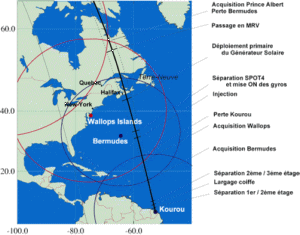
SPOT 4 is sent into a near-polar sun-synchronous orbit. The orbit must then be
adjusted to meet the other requirements of SPOT orbits, particularly phasing. It must also
be placed at the right altitude with respect to the other SPOT satellites.
The diagrams below show the relative positions chosen for the three SPOT satellites.

|
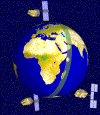
|
some figures |
an illustration |
top of page, article, section

Ariane will send SPOT 4 onto an orbit approximately 20 km below that of the
other SPOT satellites. This difference in altitude means that SPOT 4 moves faster
than the other SPOT satellites: SPOT 4 drifts with respect to the other satellites.
Advantage is taken of this relative drift as shown in the following example. We wait until
SPOT 4 approaches its final position with respect to SPOT 1 and SPOT 2,
then raise it to the altitude of the other SPOT satellites (which is also at the nominal
phasing altitude), thus stopping the drift.
To optimize altitude correction manoeuvres, the raising of the satellite to its nominal
orbit is usually split into two orbit-raising manoeuvres.
 |

SPOT 4's motion along its orbit
|
Final orbit acquisition depends on three points:
- launch date,
- launch time within the window defined above,
- launch vehicle's deviation with respect to the required altitude, i.e. the difference
between target altitude and actual altitude once SPOT 4 has separated from Ariane.
 The diagram on the left shows
SPOT 4's configuration relative to the other satellites following separation from the
launcher. This is for launches in March 1998 and assumes a launch at the beginning of
the launch window. SPOT 4's initial position and the period during which it drifts
(the final orbit acquisition period) depend on the launch date.
The diagram on the left shows
SPOT 4's configuration relative to the other satellites following separation from the
launcher. This is for launches in March 1998 and assumes a launch at the beginning of
the launch window. SPOT 4's initial position and the period during which it drifts
(the final orbit acquisition period) depend on the launch date.
Effect of launch time
 The diagram on the left shows
the relative initial positions of SPOT 4 following separation for a given launch date
(e.g. 13 March 1998) if the launch takes place at the beginning (D), in the middle
(M), or at the end (F) of the window.
The diagram on the left shows
the relative initial positions of SPOT 4 following separation for a given launch date
(e.g. 13 March 1998) if the launch takes place at the beginning (D), in the middle
(M), or at the end (F) of the window.
Effect of launch vehicle's altitude dispersion
 The
launch vehicle aims to place SPOT 4 on an orbit 20 km below the orbit of the other
SPOT satellites. The launch is considered nominal (with respect to altitude) if the
altitude is within ± 4 km of the target altitude:
The
launch vehicle aims to place SPOT 4 on an orbit 20 km below the orbit of the other
SPOT satellites. The launch is considered nominal (with respect to altitude) if the
altitude is within ± 4 km of the target altitude:
- if the orbit reached on separation is exactly that targeted, SPOT 4 gains 25
seconds on the other satellites per orbital revolution.
- if the orbit reached is 4 km below the target orbit, SPOT 4 deviates by
28 seconds per orbital revolution.
- if the orbit reached is 4 km above the target orbit, SPOT 4 deviates by
23 seconds per orbital revolution.
The time taken for final orbit acquisition depends on the drift velocity.
top of page, article, section

SPOT 4 must be placed on its final orbit within 18 days.
The strategy outlined in the paragraph on the basic principle of "final
orbit acquisition" will enable final orbit acquisition within 18 days in most
cases. However, there are two exceptions:
- the configuration following separation is such that SPOT 4 is inserted just before
its target rendezvous (though 20 km below). This is shown in the diagram for "Effect of launch date" for launches on
7 or 12 March at the beginning of the launch window. In these cases,
SPOT 4's drift is too fast to allow the two orbit-raising manoeuvres to be performed
before the rendezvous, and SPOT 4 will therefore have to complete a whole orbital
revolution (with respect to the other satellites).
- the configuration following separation is such that SPOT 4 is inserted at (or just
after) its target rendezvous, (case of 17, 22 or 27 March 1998 at the beginning
of the window), and the altitude attained leads to a slow drift.
In these two cases, the following strategy will be applied:
- SPOT 4's altitude is raised above that of the other SPOT satellites. SPOT 4's
velocity will then be lower than that of the other satellites, reversing the drift and
returning to the rendezvous.
- When SPOT 4 reaches its rendezvous, the drift is stopped by an orbit-lowering
manoeuvre.
 This
strategy, shown in a diagram for a launch on 22 March 1998 at the beginning of the
window, means that the maximum final orbit acquisition period is met but entails extra
fuel consumption.
This
strategy, shown in a diagram for a launch on 22 March 1998 at the beginning of the
window, means that the maximum final orbit acquisition period is met but entails extra
fuel consumption.
top of page, article, section

Various forces continually alter the characteristics of the SPOT orbit previously
described:
- atmospheric drag , caused by the Earth's residual atmosphere at the satellite's altitude
effectively slows the satellite. This drag depends on solar activity (which itself varies
according to an 11-year cycle).
- the combined attraction of the Sun and Moon, which reduce inclination of the orbital
plane.
Orbit control is designed to maintain the same orbit characteristics so that
SPOT 4 can fulfil its mission.
The operations control centre (CMP) checks the following
parameters:
The Operations Control Centre monitors the difference in longitude between nodes so
that at the equator it is kept within ± 3 km (mission requirement).
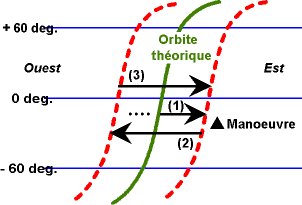 When this drift reaches the eastern limit allowed by
the mission, the Operations Control Centre programs a manoeuvre to raise the satellite
above the theoretical altitude, which makes the descending nodes drift westward
; the effect of atmospheric drag cancels out this drift and brings the satellite down to
the theoretical altitude. At this point in time, the descending nodes must be no more than
3 km to the west.
When this drift reaches the eastern limit allowed by
the mission, the Operations Control Centre programs a manoeuvre to raise the satellite
above the theoretical altitude, which makes the descending nodes drift westward
; the effect of atmospheric drag cancels out this drift and brings the satellite down to
the theoretical altitude. At this point in time, the descending nodes must be no more than
3 km to the west.
The drift continues eastward until a further manoeuvre to raise the altitude is
scheduled.
The frequency of orbit-raising manoeuvres varies between:
- two months when solar activity is low (the satellite descends about 20 cm a day),
- and two weeks when solar activity is high (the satellite can descend 5 to
10 metres a day and, occasionally, as much as 20 or 30 metres).
- altitude:
the operations control centre ensures that the satellite's
altitude over a defined point on Earth remains constant to within 5 km. Altitude is
checked and controlled during phase adjustment manoeuvres.
- Phasing at upper latitudes (60° North):
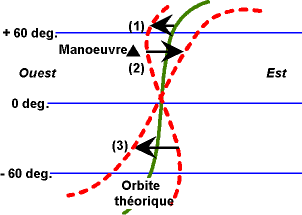 The
phasing error at 60° latitude is the sum of the phasing error at the equator due to
atmospheric drag and the phasing error due to the decrease in orbital inclination.
The
phasing error at 60° latitude is the sum of the phasing error at the equator due to
atmospheric drag and the phasing error due to the decrease in orbital inclination.
Approximately once every 18 months, an inclination correction manoeuvre is
scheduled so that the phasing at 60° North remains below 5 km. The inclination
is raised above the theoretical inclination, whilst respecting the phasing error upper
limit of 5 km.
- The local time of the descending node must be kept at 10:30
± 10 minutes for mission requirements.
The difference between local time and
the theoretical local time of 10:30 varies according to a non-linear function of
inclination and altitude.
Taking into account the frequency of inclination correction manoeuvres, the local time
is in fact kept within one or two minutes of 10:30.
top of page, article, section

page updated on 00-06-06









 When this drift reaches the eastern limit allowed by
the mission, the Operations Control Centre programs a manoeuvre to raise the satellite
above the theoretical altitude, which makes the descending nodes drift westward
; the effect of atmospheric drag cancels out this drift and brings the satellite down to
the theoretical altitude. At this point in time, the descending nodes must be no more than
3 km to the west.
When this drift reaches the eastern limit allowed by
the mission, the Operations Control Centre programs a manoeuvre to raise the satellite
above the theoretical altitude, which makes the descending nodes drift westward
; the effect of atmospheric drag cancels out this drift and brings the satellite down to
the theoretical altitude. At this point in time, the descending nodes must be no more than
3 km to the west. The
phasing error at 60° latitude is the sum of the phasing error at the equator due to
atmospheric drag and the phasing error due to the decrease in orbital inclination.
The
phasing error at 60° latitude is the sum of the phasing error at the equator due to
atmospheric drag and the phasing error due to the decrease in orbital inclination.